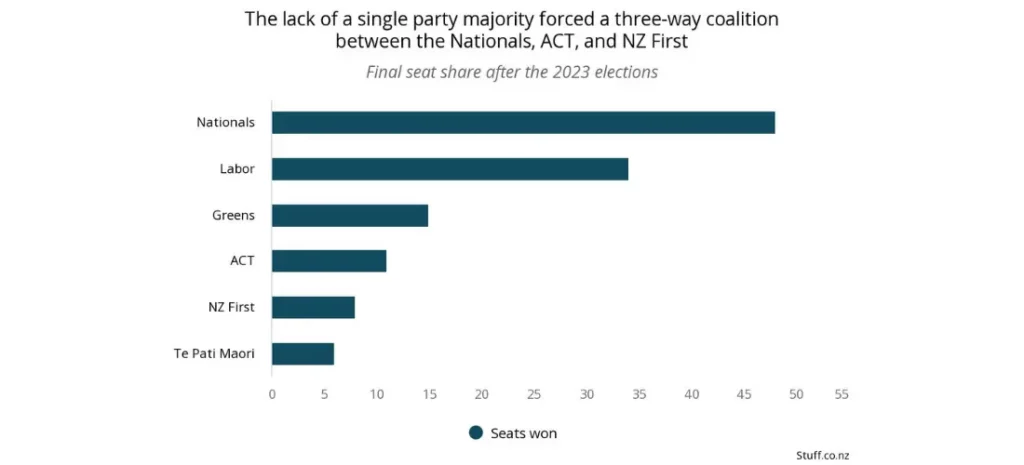
The success of the right-leaning government will depend on the coalition partners’ ability to cooperate on tough political issues
Firms in New Zealand, especially those with government contracts, should prepare for some turbulence within the public administration. Not only does the new government come with different policy objectives, but it also plans to cut over 10,000 jobs in the public service. This may even require firms to invest more time in communicating with government agencies to ensure the leadership transition does not impact the execution of existing contracts. This will be especially important for firms working on infrastructure projects, as a new infrastructure agency will be formed.
However, other government policies are not expected to have a meaningful impact in the short term. The tax cuts offered by the Nationals will only come into force in July 2024, as will the proposed revision to the income-tax brackets. While both these measures will increase household disposable income, the effects of these policies will only be felt in late 2024 or 2025. Similarly, the decision to drop the Reserve Bank’s mandate to seek maximum sustainable employment will not impact interest rates in the short term. The country’s historically low unemployment rates over the past two years have given the central bank freedom to set interest rates with little concern over its mandate to protect jobs.
Overview
The New Zealand general election wrapped up on October 14, and special votes were added to the tally by November 3, but a government was only formed on November 24. The extended coalition negotiations took place between the Nationals and its long-time partner, ACT, as well as the unpredictable NZ First Party. Christopher Luxon, the leader of the Nationals, has been appointed as the prime minister. Leaders of NZ First and ACT, Winston Peters and David Seymour, respectively, will share the role of deputy PM over the government’s three-year tenure.
The previously incumbent Labor party was thoroughly defeated at the polls, winning only 34 seats in this election, a marked drop from the 46 seats they won in 2020. Issues such as rapid growth in inflation, leadership turnover, and failure to deliver on key policies led to widespread voter frustration with the Labor government. The National party leveraged these sentiments by promising tax cuts, curbs on excessive government spending, and tough action on social issues such as crime and policing. The Nationals came out on top in the voting, winning 48 seats; however, this was not enough to form the government. To secure the minimum of 61 seats, the Nationals joined hands with trusted ally, the ACT party, as well as the NZ First party.
Our View
New Zealand’s new government represents a rightward shift in policymaking, prioritizing market-driven growth over interventionist government policies. The key policies that the Nationals-led government will pursue are cutting taxes to help households contend with rising cost pressures, removing the central bank’s mandate to seek maximum sustainable employment―ensuring its sole focus is on maintaining price stability, cutting government expenditure, and loosening labor protections. Though most of these policies aim to reduce the role of the government in the economy, one area where spending will increase is public infrastructure.
However, while there are several areas of agreement between the three ruling parties, their ideologies are not in complete alignment. This is especially true with the inclusion of the ideologically elusive NZ First Party in the government. The Nationals and ACT, while not always in agreement, broadly adhere to neoliberal economic principles. NZ First, on the other hand, does not have the same ideological consistency and is willing to work with parties across the political spectrum. Most recently, NZ First aligned with the left-leaning Labor party to form the government in 2017. This divergence in ideologies and agendas creates potential for friction in policymaking that could lead to consistent challenges. For example, the Nationals hoped to fund its signature tax cuts through revenues generated by allowing foreign purchases of homes priced over NZD 2 million. However, NZ First vetoed the proposal to allow property purchases from foreigners, as it initiated the ban on such purchases in 2017. While the tax cuts are planned to go through, they will be funded through revenues collected through reversals in legislation that discouraged smoking (a measure that NZ First campaigned for). Similarly, the Nationals promised 10,000 new EV chargers during its campaign, but during coalition talks the ACT pushed back on this goal. Since the ACT made strict fiscal management a key campaign promise, it argued that such investments should only go through if they pass cost-benefit evaluations.
Thus, a key factor that will determine the new government’s efficacy moving forward will be the ability of these three ideologically distinct parties to cooperate and compromise on thorny political issues. However, recent evidence suggests that such cooperation is not a given. The coalition talks took three weeks to conclude after the final vote count was announced, with plenty of disagreements and vitriol between the party leaders. Another concerning point is the announcement of two deputy prime ministers, who will each hold the position for half of the government’s tenure in office―a first for New Zealand politics.
At FrontierView, our mission is to help our clients grow and win in their most important markets. We are excited to share that FiscalNote, a leading technology provider of global policy and market intelligence has acquired FrontierView. We will continue to cover issues and topics driving growth in your business, while fully leveraging FiscalNote’s portfolio within the global risk, ESG, and geopolitical advisory product suite.
Subscribe to our weekly newsletter The Lens published by our Global Economics and Scenarios team which highlights high-impact developments and trends for business professionals. For full access to our offerings, start your free trial today and download our complimentary mobile app, available on iOS and Android.

